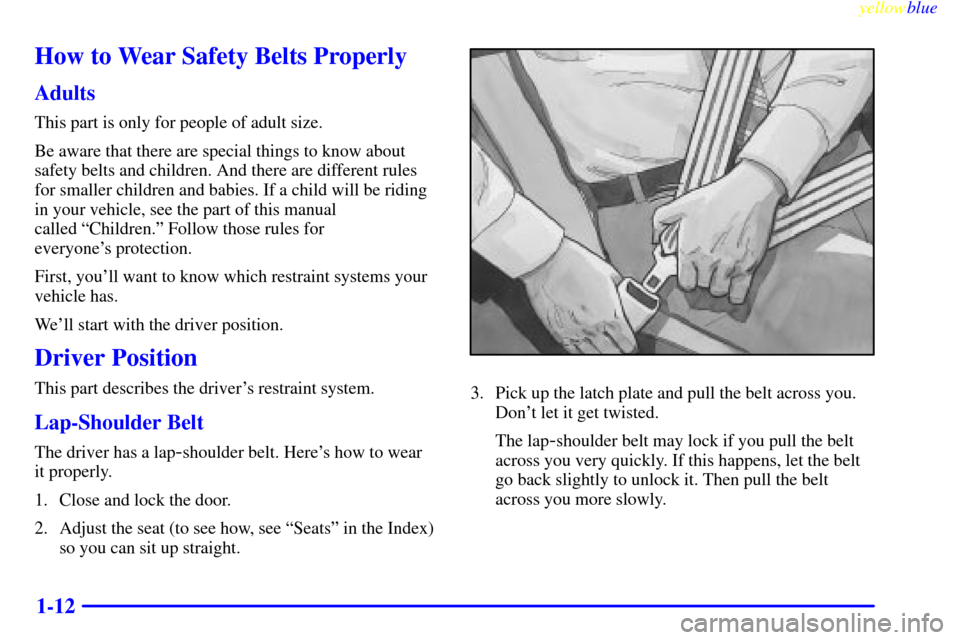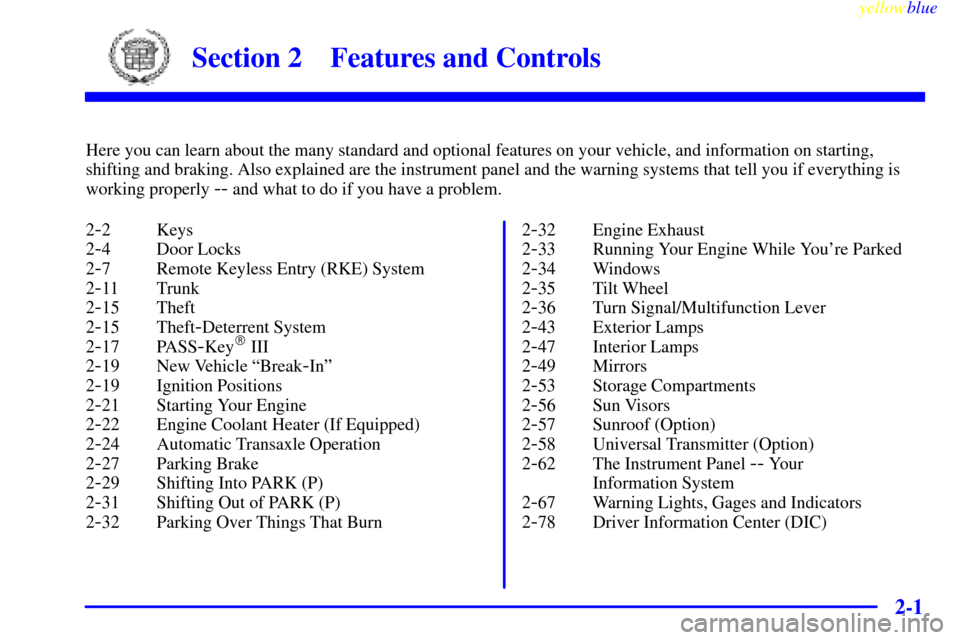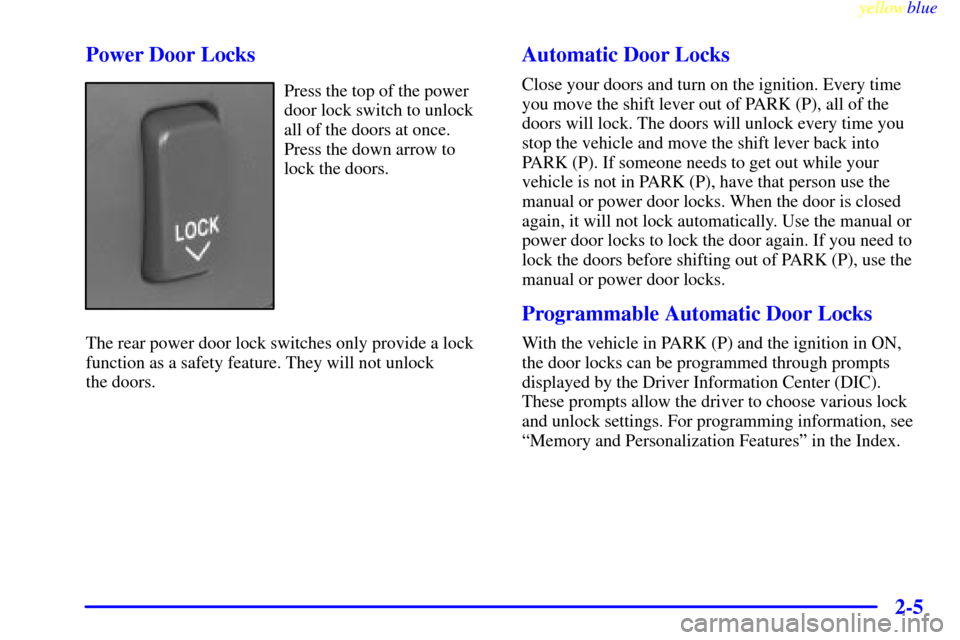Page 5 of 362
yellowblue
v
For example,
these symbols
are used on an
original battery:
CAUTION
POSSIBLE
INJURY
PROTECT
EYES BY
SHIELDING
CAUSTIC
BATTERY
ACID COULD
CAUSE
BURNS
AVOID
SPARKS OR
FLAMES
SPARK OR
FLAME
COULD
EXPLODE
BATTERY
These symbols
are important
for you and
your passengers
whenever your
vehicle is
driven:
DOOR LOCK
UNLOCK
FASTEN
SEAT
BELTS
POWER
WINDOW
AIR BAG
These symbols
have to do with
your lamps:
MASTER
LIGHTING
SWITCH
TURN
SIGNALS
PARKING
LAMPS
HAZARD
WARNING
FLASHER
DAYTIME
RUNNING
LAMPS
FOG LAMPS
These symbols
are on some of
your controls:
WINDSHIELD
WIPER
WINDSHIELD
WASHER
WINDSHIELD
DEFROSTER
REAR
WINDOW
DEFOGGER
VENTILATING
FAN
These symbols
are used on
warning and
indicator lights:
ENGINE
COOLANT
TEMP
BATTERY
CHARGING
SYSTEM
BRAKE
COOLANT
ENGINE OIL
PRESSURE
ANTI-LOCK
BRAKES
Here are some
other symbols
you may see:
FUSE
LIGHTER
HORN
SPEAKER
FUEL
Vehicle Symbols
These are some of the symbols you may find on your vehicle.
Page 18 of 362

yellowblue
1-12
How to Wear Safety Belts Properly
Adults
This part is only for people of adult size.
Be aware that there are special things to know about
safety belts and children. And there are different rules
for smaller children and babies. If a child will be riding
in your vehicle, see the part of this manual
called ªChildren.º Follow those rules for
everyone's protection.
First, you'll want to know which restraint systems your
vehicle has.
We'll start with the driver position.
Driver Position
This part describes the driver's restraint system.
Lap-Shoulder Belt
The driver has a lap-shoulder belt. Here's how to wear
it properly.
1. Close and lock the door.
2. Adjust the seat (to see how, see ªSeatsº in the Index)
so you can sit up straight.
3. Pick up the latch plate and pull the belt across you.
Don't let it get twisted.
The lap
-shoulder belt may lock if you pull the belt
across you very quickly. If this happens, let the belt
go back slightly to unlock it. Then pull the belt
across you more slowly.
Page 29 of 362
yellowblue
1-23
The driver's side impact air bag is in the side of the
driver's seatback closest to the door.
The right front passenger's side impact air bag is in the
side of the passenger's seatback closest to the door.
CAUTION:
If something is between an occupant and an air
bag, the bag might not inflate properly or it
might force the object into that person. The path
of an inflating air bag must be kept clear. Don't
put anything between an occupant and an air
bag, and don't attach or put anything on the
steering wheel hub or on or near any other air
bag covering and don't let seat covers block the
inflation path of a side impact air bag.
Page 32 of 362

yellowblue
1-26
Your vehicle has a feature that will automatically unlock
the doors and turn the interior lamps on when the frontal
air bags inflate (if battery power is available). You can
lock the doors again and turn the interior lamps off by
using the door lock and interior lamp controls.
In many crashes severe enough to inflate an air bag,
windshields are broken by vehicle deformation.
Additional windshield breakage may also occur from the
right front passenger air bag.
�Air bags are designed to inflate only once. After an
air bag inflates, you'll need some new parts for your
air bag system. If you don't get them, the air bag
system won't be there to help protect you in another
crash. A new system will include air bag modules
and possibly other parts. The service manual for your
vehicle covers the need to replace other parts.
�Your vehicle is equipped with a crash sensing and
diagnostic module, which records information about
the frontal air bag system. The module records
information about the readiness of the system, when
the sensors are activated and driver's safety belt
usage at deployment. Some modules also record
speed, engine rpm, brake and throttle data.
�Let only qualified technicians work on your
air bag systems. Improper service can mean that
an air bag system won't work properly. See your
dealer for service.
NOTICE:
If you damage the covering for the driver's or the
right front passenger's air bag, or the air bag
covering on the driver's and right front
passenger's seatback, the bag may not work
properly. You may have to replace the air bag
module in the steering wheel, both the air bag
module and the instrument panel for the right
front passenger's air bag, or both the air bag
module and seatback for the driver's and right
front passenger's side impact air bag. Do not
open or break the air bag coverings.
Servicing Your Air Bag-Equipped Vehicle
Air bags affect how your vehicle should be serviced.
There are parts of the air bag systems in several places
around your vehicle. Your dealer and the Seville Service
Manual have information about servicing your vehicle
and the air bag systems. To purchase a service manual,
see ªService and Owner Publicationsº in the Index.
Page 53 of 362

2-
yellowblue
2-1
Section 2 Features and Controls
Here you can learn about the many standard and optional features on your vehicle, and information on starting,
shifting and braking. Also explained are the instrument panel and the warning systems that tell you if everything is
working properly
-- and what to do if you have a problem.
2
-2 Keys
2
-4 Door Locks
2
-7 Remote Keyless Entry (RKE) System
2
-11 Trunk
2
-15 Theft
2
-15 Theft-Deterrent System
2
-17 PASS-Key� III
2
-19 New Vehicle ªBreak-Inº
2
-19 Ignition Positions
2
-21 Starting Your Engine
2
-22 Engine Coolant Heater (If Equipped)
2
-24 Automatic Transaxle Operation
2
-27 Parking Brake
2
-29 Shifting Into PARK (P)
2
-31 Shifting Out of PARK (P)
2
-32 Parking Over Things That Burn2
-32 Engine Exhaust
2
-33 Running Your Engine While You're Parked
2
-34 Windows
2
-35 Tilt Wheel
2
-36 Turn Signal/Multifunction Lever
2
-43 Exterior Lamps
2
-47 Interior Lamps
2
-49 Mirrors
2
-53 Storage Compartments
2
-56 Sun Visors
2
-57 Sunroof (Option)
2
-58 Universal Transmitter (Option)
2
-62 The Instrument Panel -- Your
Information System
2
-67 Warning Lights, Gages and Indicators
2
-78 Driver Information Center (DIC)
Page 55 of 362
yellowblue
2-3
Master Key Valet Key
There is a master key that works in all of the lock
cylinders (driver's door, trunk, ignition and glove box).
There is also a valet key which only operates the
driver's door and the ignition.Both the master and valet keys have a transponder
embedded into the key for security and theft deterrence.
The keys also come with a bar code tag. Keep the bar
code tag in a safe place. If you lose your key you will be
able to have a new one made using the bar code tag.
The replacement key must have a transponder embedded
in it.
NOTICE:
Your vehicle has a number of new features that
can help prevent theft. You can have a lot of
trouble getting into your vehicle if you ever lock
your key inside and you may have to damage
your vehicle to get in. Be sure you have an
extra key.
Page 56 of 362

yellowblue
2-4
Door Locks
CAUTION:
Unlocked doors can be dangerous.
Passengers -- especially children -- can easily
open the doors and fall out. When a door is
locked, the inside handle won't open it.
Outsiders can easily enter through an unlocked
door when you slow down or stop your vehicle.
This may not be so obvious: You increase the
chance of being thrown out of the vehicle in a
crash if the doors aren't locked. Wear safety belts
properly, lock your doors, and you will be far
better off whenever you drive your vehicle.
There are several ways to lock and unlock your vehicle.
From the outside, use either the key or the Remote
Keyless Entry (RKE) transmitter.Because your vehicle has the theft
-deterrent system, you
must unlock the doors with the key or RKE transmitter
to avoid setting off the alarm.
The manual lock is on the
top of the door panel near
the window. Push the
manual lock lever down to
lock the door from the
inside. To unlock the door,
raise the lock lever.
Central Door Unlocking System
When unlocking the driver's door, you can unlock the
other doors by holding the key in the turned position for
a few seconds or by quickly turning the key twice in the
lock cylinder.
Page 57 of 362

yellowblue
2-5 Power Door Locks
Press the top of the power
door lock switch to unlock
all of the doors at once.
Press the down arrow to
lock the doors.
The rear power door lock switches only provide a lock
function as a safety feature. They will not unlock
the doors.
Automatic Door Locks
Close your doors and turn on the ignition. Every time
you move the shift lever out of PARK (P), all of the
doors will lock. The doors will unlock every time you
stop the vehicle and move the shift lever back into
PARK (P). If someone needs to get out while your
vehicle is not in PARK (P), have that person use the
manual or power door locks. When the door is closed
again, it will not lock automatically. Use the manual or
power door locks to lock the door again. If you need to
lock the doors before shifting out of PARK (P), use the
manual or power door locks.
Programmable Automatic Door Locks
With the vehicle in PARK (P) and the ignition in ON,
the door locks can be programmed through prompts
displayed by the Driver Information Center (DIC).
These prompts allow the driver to choose various lock
and unlock settings. For programming information, see
ªMemory and Personalization Featuresº in the Index.